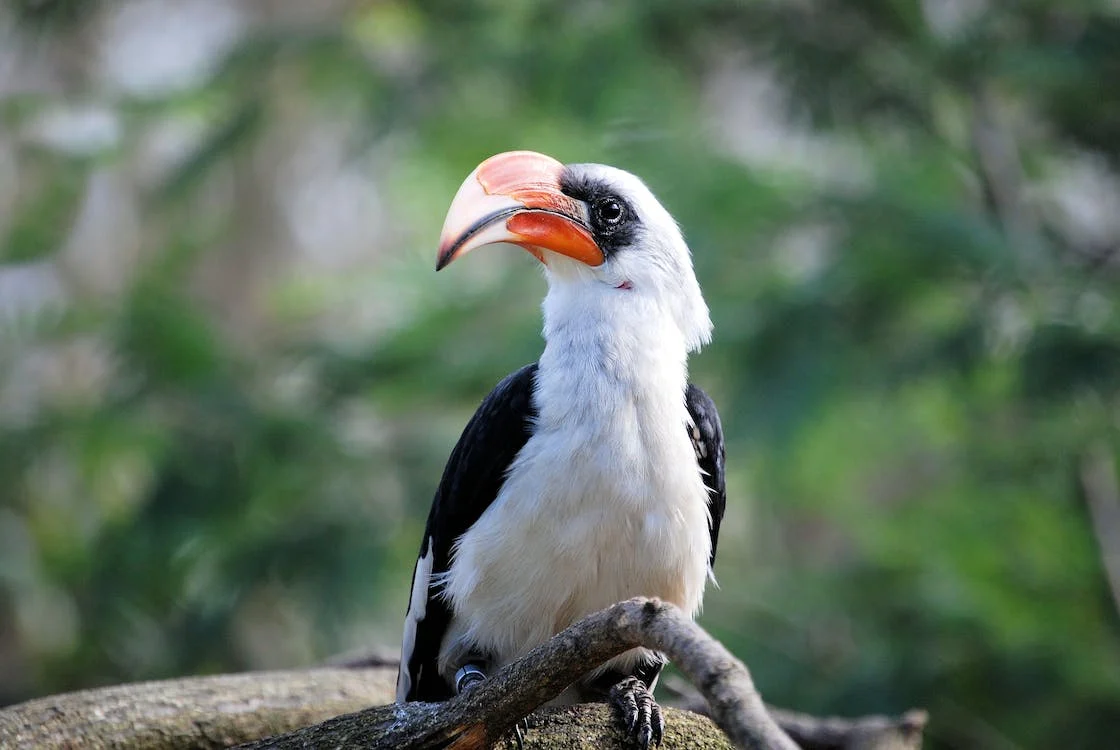It is a large, black and white hornbill that thrives in dense woodland, thickets, coastal and riverine forests. This bird can hardly be noticeable as it eats large fruits in the forest, but, in flight, it stands out with its loud wingbeats and its renowned baby-like wail “whaa-waa-waaa” call. While it can resemble the Black-and-white-casque Hornbill in flight, the Trumpeter Hornbill is distinguished with its thinner rear edges and almost dark wings.
Read further to know more about the Trumpeter Hornbill.
What is a Trumpeter Hornbill?
Trumpeter Hornbill (Bycanistes bucinator) is a medium-sized bird belonging to the Bucerotidae family. It is a pretty gregarious bird, living in groups composed of two to five members. The species is a resident to tropical and evergreen forests, feeding mostly on fruits and large insects. Like its hornbill cousins, the female hornbill seals itself inside the nest compartment.
Its seven levels of classification are as follows:
Kingdom: Animalia
Phylum: Chordata
Class: Aves
Order: Bucerotiformes
Family: Bucerotidae
Genus: Bycanistes
Species: B. bucinator
Trumpeter Hornbill Physical Description
Like all its cousins, trumpeter Hornbills have a casque on top of their beak, growing larger in males than in females. The birds’ plumage is generally black, but white and gray on the belly and the underwing tetrices. Their eyes are covered with skin, ranging from vibrant pink to dark purple tone. Legs and feet are also black. They are medium-sized birds, growing from 23 to 26 inches or 58 to 63.5 centimeters, and weighing 450 to 680 grams. They are easily distinguishable through their coloring and large gray casque.
Where can they be spotted?
Trumpeter Hornbills thrives in humid forest woodlands, savannas, and coastal shrubs. They occur primarily in central and southeastern Africa.
Interesting Facts You Should Know About the Trumpeter Hornbill
Trumpeter Hornbills are omnivorous birds, having a high-fruit preferring mostly fruits, but will all feed on insects, eggs, some small animals, and small birds. These birds will readily feed on fruit crops such as litchi, pawpaw, nuts, and guava.
The species is often found singularly or by pair during the breeding period. However, they can form flocks, and communally roosts outside the seasons. These birds fly long distances to search for food during drier conditions. Being a fruit-eater, they are vital seed dispersers in forests.
Like other hornbills, the trumpeter hornbill nests in tree cavities or rock caves. The female will seal herself inside using mud collected by the male. A small hole is left so the male can supply food for her and the hicks. Meanwhile, the female will also shed old tail and flight feathers at the start of the nesting period.
Trumpeter hornbill females lay two to four eggs and incubation it for around 25 days. However, she will remain inside the nest for another 50 days after the eggs have hatched. After the said timeframe, she will break the seal, go out of the nest. The broods will begin foraging with their parents about another week after. During the course of the incubation and nesting, the male trumpeted hornbill feeds the female and the chicks.
Trumpeter hornbills are not classified as endangered as their population is stable and widespread throughout their range. They fall under least concern species under the IUCN Red List.
WILDLIFE PARKS AND RESERVES WHERE THIS SPECIES IS FOUND:
ZAMBIA
ZIMBABWE
SOUTH AFRICA
BOTSWANA BIRDS | SOUTH AFRICA BIRDS
NAMIBIA BIRDS | ZAMBIA BIRDS | ZIMBABWE BIRDS

